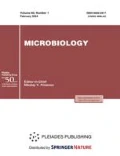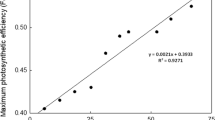Abstract—
The biochemical composition of Arthrospira (Spirulina) platensis (Nordstedt) Gomont after long-term storage in the state of anhydrobiosis (4 years, 17 years) was determined by the standard methods. It was shown that protein content (55.3–61.2%) and total carbohydrates content (13.0–15.6%) in cyanobacterial cells were in agreement with the data known from the literature and with our results obtained at the onset of storage. The biomass had low content of free nucleotides (1.8–2.6%), lipids (1.3–11.0%), and especially pigments (0.5–1.3%, 0.03–0.12%, 1.4–2.0%, 0.03–0.05% for chlorophyll a, carotenoids, C-phycocyanin, and allophycocyanin, respectively). The content of nucleic acids content was 3.1–24.0 and 0.11–0.16% for RNA and DNA, respectively. Microscopic examination of A. platensis (17 years of storage) showed high numbers of irreversibly damaged and dead cells (34.2 and 65.8%, respectively). To determine the quantitative and morphological parameters of associated microflora, a complex physicochemical treatment (methanol, ultrasound, and centrifugation) of the reactivated cyanobacterial suspension proved the most efficient. Three main groups were distinguished in the morphological structure of the microbiome (rod-shaped, rounded, and convoluted forms). The community was dominated by rod-shaped forms: large and small rods accounted for 60.5 and 14.4%, respectively. Mycelial forms (thin filaments), cocci, and convoluted forms were less common. On average, the volume of a bacterial cell was 0.27 ± 0.04 µm3. The contribution of bacteria to the biomass of A. platensis varied from 3.3 to 11.3% (8.3 ± 4.4% on average) of the dry weight of A. platensis. It has been suggested that the biochemical parameters and viability of cyanobacteria were affected by the accompanying microflora.





Similar content being viewed by others
REFERENCES
Agatova, A.I., Rukovodstvo po sovremennym biokhimicheskim metodam issoledovaniya vodnykh sistem, perspektivnykh dlya promysla i marikul’tury (Guidebook on Modern Biochemical Methods for Investigation of Aquatic Systems Promising for Fishery and Mariculture), Moscow: VNIRO, 2004.
Beker, M.A., Damberg, B.E., and Rapoport, A.I., Anabioz mikroorganizmov (Microbial Anabiosis), Riga: Zinatne, 1981.
Bratbak, G., Kemp, P.F., Sherr, B.F., Sherr, E.B., and Cole, J.J., Microscope methods for measuring bacterial biovolume: epifluorescence microscopy, scanning electron microscopy, and transmission electron microscopy, in Handbook of Methods in Aquatic Microbial Ecology, Cole, J.J., Ed., Boca Raton: CRC, 1993, Ch. 36, pp. 309–317. https://doi.org/10.1201/9780203752746
Ciferri, O., Spirulina, the edible microorganism, Microbiol. Rev., 1983, vol. 47, pp. 551‒578.
Falquet, J. and Hurni, J.P., Spiruline Aspects Nutritionnels, Antenna Technologies, 2006.
Faucher, O., Coupal, B., and Leduy, A., Utilization of scawater—urea as a culture medium for Spirulina maxima, Can. J. Microbiol., 1979, vol. 25, p. 752.
Gevoriz, R.G. and Nekhoroshev, M.V., Quantitative determination of mass share of C-phycocyanin and allophycocyanin in dry biomass of Spirulina (Arthrospira) platensis North. Geitl. Cold extraction, Sevastopol, 2017. https://repository.marine-research.org/handle/299011/46 (accessed 19.10.2021).
Kallmeyer, J., Smith, D.C., Spivac, A.J., and D’Hondt, S., New cell extraction procedure applied to deep subsurface sediments, Limnol. Oceanogr. Methods, 2008, vol. 6, pp. 236–245.
Kannaujiya, V.K. and Sinha, R.P., Thermokinetic stability of phycocyanin and phycoerythrin in food-grade preservatives, J. Appl. Phycol., 2016, vol. 28, pp. 1063–1070. https://doi.org/10.1007/s10811-015-0638-x
Kharchuk, I.A., Dynamics of the components of the biochemical composition of Spirulina platensis Nords. during anhydrobiosis, Ekol. Morya, 2008, no. 76, pp. 67‒71.
Kharchuk, I.A., Effect of storage duration on the viability of Spirulina platensis (Nordst.) cells in the state of anhydrobiosis, Ekol. Morya, 2007, no. 74, pp. 80–83.
Kharchuk, I.A., Method for long-term storage of algae, RF Patent no. 2541452 C1, 2015.
Kharchuk, I.A., Dynamics of viability and components of the biochemical composition of Arthrospira (Spirulina) platensis (Nords) Gomont depending on dehydration temperature during transition to the anhydrobiosis state, Vopr. Sovr. Al’gol., 2018, no. 1 (16). http://algology.ru/1258.
Kopytov, Yu.P., Divavin, I.A., and Tsymbal, I.M., Scheme of comprehensive biochemical analysis of hydrobionts, Proc. Conf. “Rational Utilization of Sea Resources, an Important Contribution to Implementation of the Food Programme,” Sevastopol: InBYuM AN USSR, 1985, pp. 227–231. Available from VINITI, no. 2556-85.
Liu, Q., Huang, Y., Zhang, R., Cai, T., and Cai, Y., Medical application of Spirulina platensis derived C-phycocyanin, Evid. Based Complement. Alternat. Med., 2016, vol. 2016, p. 7803846. https://doi.org/10.1155/2016/7803846
Lowry, O.H., Rosebrough, N.J., Farr, A.L., and Randall, R.J.P., Protein measurement with Folin phenol reagent, J. Biol. Chem., 1951, vol. 193, pp. 265–275.
Lunau, M., Lemke, A., Walther, K., Martens-Habbena, W., and Simon, M., An improved method for counting bacteria from sediments and turbid environments by epifluorescence microscopy, Environ. Microbiol., 2005, vol. 7, pp. 961–968.
Meisel’ M.N., Medvedeva, G.A., and Alekseeva, V.M., On detection of living, damaged, and dead microorganisms, Mikrobiologiya, 1961, vol. 30, pp. 855–862.
Mogale, M., Identification and quantification of bacteria associated with cultivated Spirulina and impact of physiological factors, MA Thesis, Univ. Cape Town, 2016. http://hdl.handle.net/11427/22921.
Nalage, D., Khedkar, G., Kalyankar, A., Sarkate, A., Ghodke, S., Bedre, V.B., and Khedkar, C.D., Single cell proteins, in The Encyclopedia of Food and Health, Caballero, B., Finglas, P., and Toldra, F., Eds., Oxford: Academic, 2016, vol. 4, pp. 790–794.
Rauen, T.V., Khanaichenko, A.N., and Mukhanov, V.S., Effect of microalgae and their filtrates on bacterial abundance in the environment of turbot cultivation, Mor. Ekol. Zh., 2011, vol. 10, no. 3, pp. 48–56.
Rowan, K.S., Photosynthetic Pigments of Algae, Cambridge: Cambridge Univ. Press, 1989.
Rylkova, O.A., Gulin, S.B., and Pimenov, N.V., Determination of the total microbial abundance in Black Sea bottom sediments using flow cytometry, Microbiology (Moscow), 2019, vol. 88, pp. 700‒708.
Schlegel, H.G., Allgemine Mikrobiologie, Stuttgart: Georg Tieme, 1985 [Russ. Transl. Moscow: Mir, 1987].
Sirenko, L.A., Sakevich, A.I., and Osipovich, L.F., Metody fiziologo-biokhimicheskogo issledovaniya vodoroslei v gidrobiologicheskoi praktike (Methods for Physiological and Biochemical Investigation of Algae in Hydrobiological Practice, Kiev: Nauk. Dumka, 1975.
Slizen’, V.V., Kiril’chik, E.Yu., Shaban, Zh.G., Chernoshei, D.A., and Kanashkova, T.A., Laboratornyi praktikum po obshchei mikrobiologii (Laboratory Practical Course in General Microbiology), Minsk: BGMU, 2020.
Spirin, A.S., Spectrophotometric determination of the total amount of nucleic acids, Biokhimiya, 1958, vol. 23, pp. 656–662.
Stadnichuk, I.N., Phycobiliproteins, Itogi Nauki i Tekhnimi. Ser. Biol. Khim., Moscow: VINITI, 1990, vol. 40.
Tarkhova, E.P., Microorganisms accompanying Spirulina platensis in an enrichment nutrient culture, Ekol. Morya, 2005, no. 70, pp. 49–52.
Vardaka, E., Kormas, K.A., Katsiapi, M., Genitsaris, S., and Moustaka-Gouni, M., Molecular diversity of bacteria in commercially available “Spirulina” food supplements, PeerJ., 2016, vol. 4, p. 1610.
Velji, M.I. and Albright, L.J., Microscopic enumeration of attached marine bacteria of seawater, marine sediment, fecal matter and kelp blade samples following pyrophosphate and ultrasound treatments, Can. J. Microbiol., 1986, vol. 32, pp. 121–126.
Vonshak, A., Ed., Spirulina platensis (Arthrospira). Physiology, Cell-Biology and Biotechnology, CRC, 1997.
ACKNOWLEDGMENTS
The authors are grateful to V.N. Lishaev for his help in operating the electron microscope and to A.B. Borovkov for valuable comments, which resulted in improved quality of the text.
Funding
The work was carried out within the framework of the State Assignment for the Institute of Biology of the Southern Seas, Russian Academy of Sciences “Investigation of the Mechanisms of Controlling the Production Processes in Biotechnological Complexes for Development of the Scientific Foundations of Production of Biologically Active Substances and Technical Products of Marine Genesis,” State Registration no. 121030300149-0.
Author information
Authors and Affiliations
Corresponding author
Ethics declarations
The authors declare that they have no conflicts of interest. This article does not contain any studies involving animals or human participants performed by any of the authors.
Additional information
Translated by P. Sigalevich
Rights and permissions
About this article
Cite this article
Kharchuk, I.A., Rylkova, O.A. & Beregovaya, N.M. State of Cyanobacteria Arthrospira platensis and of Associated Microflora during Long-Term Storage in the State of Anhydrobiosis. Microbiology 91, 704–712 (2022). https://doi.org/10.1134/S0026261722601786
Received:
Revised:
Accepted:
Published:
Issue Date:
DOI: https://doi.org/10.1134/S0026261722601786




